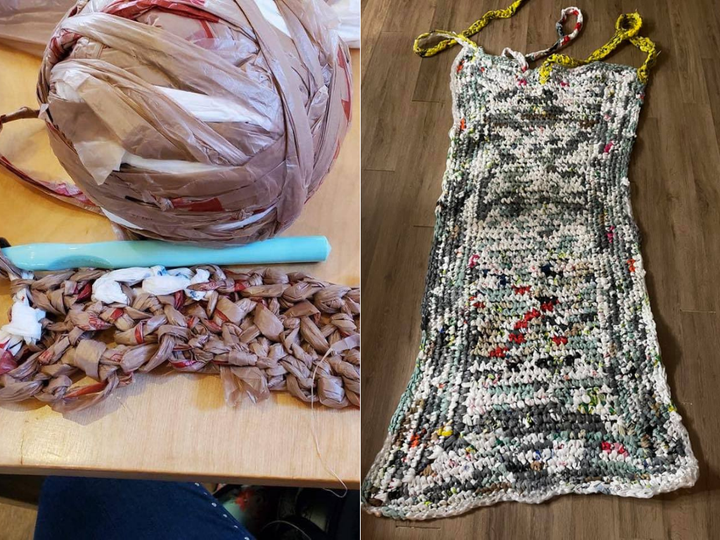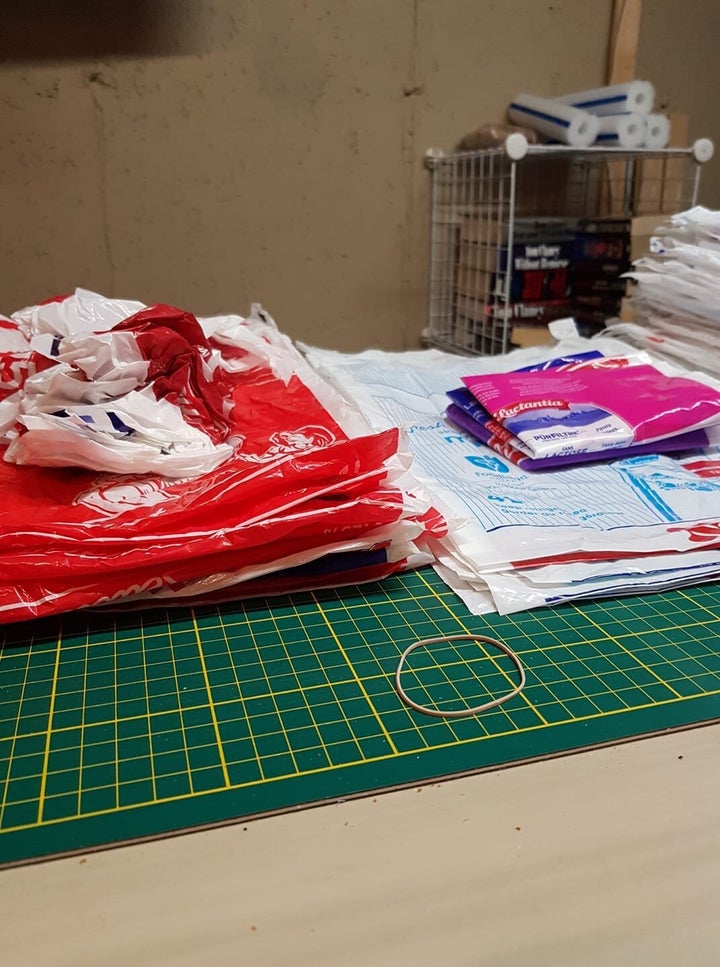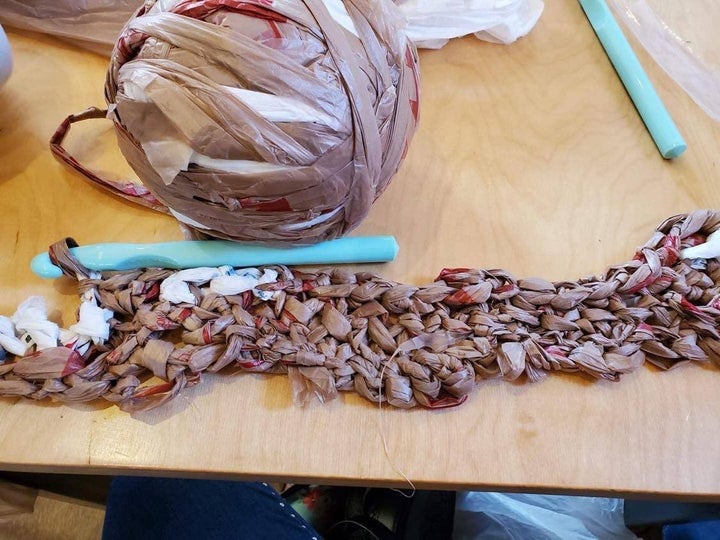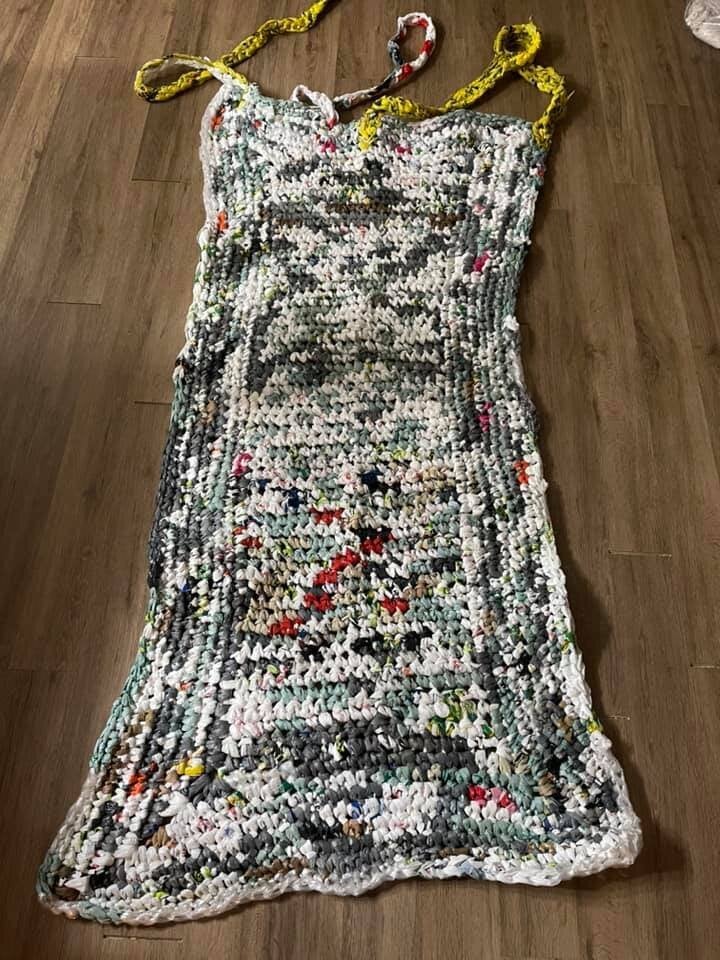
Have too many plastic bags to count? If you live in Ontario’s Kitchener-Waterloo region, a Facebook group will happily take them off your hands and turn them into mats for people experiencing homelessness who sleep outdoors.
Founded by Waterloo, Ont. resident Kathy Kibble, members of “Bags To Sleeping Mats” have been hard at work collecting and repurposing plastic bags since late last year. Kibble told HuffPost Canada that the group is still in its early stages, having only handed off a handful of the multipurpose mats so far, but that they’ve been appreciated by recipients so far.
“The mats are well-received,” said Kibble. The group has made adjustments, too, based on recipients’ feedback, for future mats: “One gentleman asked for a wider one, to wrap himself in, as well as to cover under and above his body for warmth.”
Sleeping mats made out of plastic bags have several advantages. ”[The mats are] lightweight, bedbugs and lice don’t like them, and when they get dirty may be easily hosed off,” reads the website’s main page.
The group has 10 drop-off locations for bag donations in the region so far, and they ask that donors sanitize and properly stack their bags beforehand. Here’s how the group and other crafty Canadians crochet these multipurpose mats from plastic bags:
First, bags are flattened, folded and cut into strips.

Volunteers turn the strips into a yarn-like ball.

That ball of “plarn” and a hook are used to make the mat, with a simple crocheting technique.
Variants of the technique can be found in many online tutorials and videos, including an instructional clip shot by Shaw TV Nanaimo and a CBC segment about New Brunswick resident Renee Outhouse’s similar initiative, published last February.

From there, the mats are ready for sleeping, sitting, or keeping belongings in place.

Kibble’s website has a simple seven-step tutorial available for those who’d like to participate in their efforts. It’s a creative, kid-friendly activity that’s best for those with ample time on their hands: Kibble told The Waterloo Region Record that each mat takes 700 bags and up to 60 hours to make.
“This initiative can be done at home. I think this is why it is appealing to volunteers at this time,” she said.
Not crafty? Donating hygiene products and socks is another form of allyship
Canadians can support calls for affordable housing and community-driven government responses, if they want to end homelessness for good. But in the immediate term, treating someone with kindness with friendly chatter or asking what they need the most—as Cathy ten Broeke, director Minnesota Interagency Council on Homelessness, does—can go a long way.
For many street-involved Canadians, a sleeping mat may be helpful, but may not be a top item on their list of priorities.
Some homeless people may request financial assistance or gift cards to chains like Tim Hortons. Advocates like New Statesman’s Matt Broomfield say that giving to someone asking for spare change should be done unconditionally, writing that “in the absence of an adequate government response, charitable giving and hostels remain lifesavers to many thousands of people.”
If your preference is to give something material, socks and other footwear are the most-requested items. They’re especially needed to get through Canadian winters, as the cold and rock salt can be felt through thin footwear. A few pairs of quality thick socks are more helpful than cheap sweat socks, writes Toronto Star writer Meg Inwood.
“A person who hasn’t showered in days, whose boots are almost constantly wet, and who is often walking around for a couple of days at a time can walk holes through a pair of those socks in two days,” Inwood explained, before recommending the wool socks that are sold at Dollarama. “They give you more bang for your buck, even if there are only half as many pairs, because each pair lasts three to four times as long.”
Hygiene products, containing items such as hand sanitizer and wet wipes, are also in demand during a pandemic; homeless Ontarians are five times more likely to die from COVID-19, a recent Canadian Medical Association Journal study found. Pads and tampons are always good donations too.
Sleeping mats may be useful for keeping one’s sleeping side dry, but those that aren’t wide enough to be doubled over as a cover won’t do much against falling snow or rain. Durable sleeping gear such as tents, sleeping bags, and tiny shelters, may be appreciated. Tarps can also provide privacy from passersby, which can be a top concern at night.
Food and drinks can also be helpful, but again, may not be the biggest priority for a person experiencing homelessness.
“Most of us like to have the ability to choose what we want to eat and when we want to eat it,” states Homeless Hub’s website. “Giving a panhandler a coffee instead of cash may be your preference, but if it’s the fifth coffee they’ve been handed in 20 minutes, they may well refuse it.”
Fred Victor, a Toronto-based homelessness support organization, emphasizes of making sure whatever is given includes a bag for easy carrying.
Also on HuffPost: